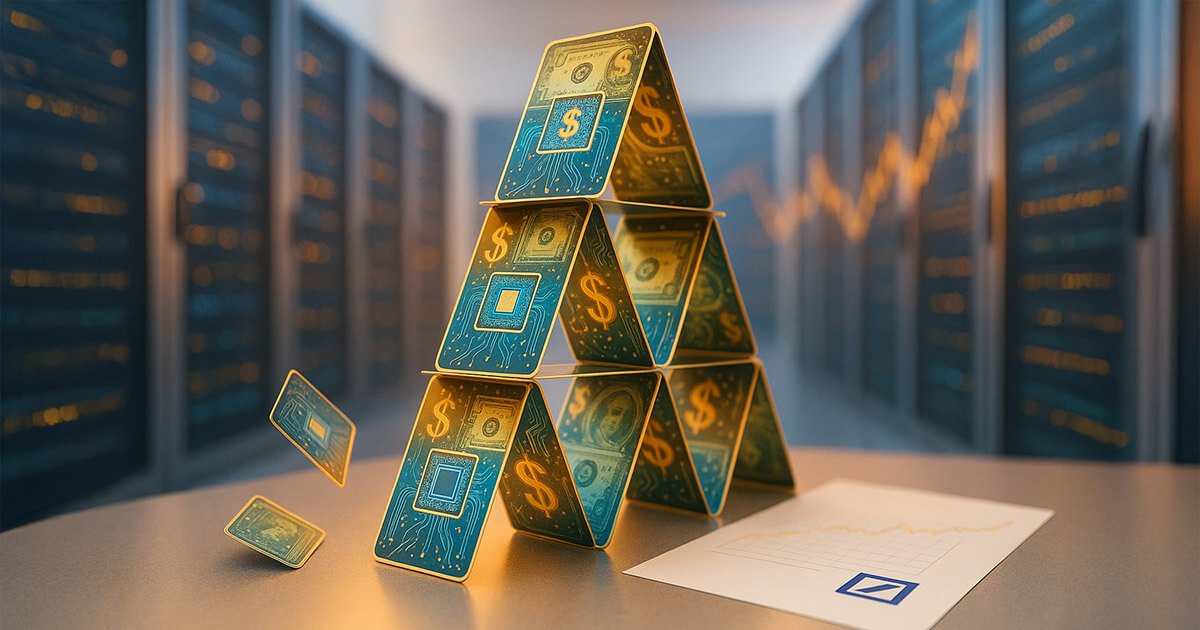The AI gold rush may be keeping the U.S. economy afloat, but according to Deutsche Bank, its current trajectory looks anything but sustainable.
A new research note from the German lender warns that AI capital expenditures have reached such extraordinary heights that they are single-handedly preventing the U.S. from tipping into recession.
Deutsche Bank isn’t the only one that’s noticed the outsized impact AI is having on the economy. The Kobeissi Letter posted a chart by Arch Global Economies showing that software and technology investment’s contribution to U.S. real GDP growth surpassed 1 percentage point for the first time in history. It has also exceeded the previous peak reached during the dot-com bubble in 1998.

“This is unprecedented… The AI boom is driving economic growth.”
But with spending racing ahead of actual productivity gains, Deutsche Bank see storm clouds on the horizon.
Deutsche Bank cites capex-fueled growth, not software output
The scale is mind-boggling. Goldman Sachs estimates that global AI-related capex hit $368 billion between early 2023 and August 2025. Most of this money has gone into physical infrastructure, like building data centers, upgrading power supply, and installing high-grade equipment.
Yet, the actual output from AI software, its promised leap in productivity and efficiency, remains limited. In fact, Deutsche Bank notes that if you strip out tech-driven spending, real GDP growth in the U.S. is hovering around 0% in 2024 and 2025. Translation? Without data centers, the economy would already be in recession.
And here’s the catch: to keep contributing fresh points to GDP, the tech cycle would need to accelerate “parabolically” quarter after quarter, according to Deutsche Bank. That kind of endless upward slope is mathematically improbable, if not impossible.
Instead, the current AI boom looks increasingly like a sprint: unsustainably fast, front-loaded with construction, and destined to slow once the infrastructure build-out plateaus. As tech stocks have been responsible for roughly half the S&P 500’s gains this year, the risks aren’t limited to GDP; they extend directly into financial markets.
The $800 billion shortfall
Consultancy Bain & Co. adds more fuel to the skeptics’ fire. Their estimate suggests that by 2030, the AI sector would require $2 trillion annually to fund demand for computing power. Yet even factoring in efficiency gains and cost savings, the world is still staring down an $800 billion revenue shortfall.
That gap raises the uncomfortable question: who foots the bill? If demand for AI compute doesn’t line up with revenues, the industry could face a reckoning with overcapacity and squeezed margins, eerily reminiscent of the dot-com era.
There is, however, a more measured outlook. Goldman Sachs believes AI productivity gains will eventually materialize, boosting U.S. GDP by about 0.4 percentage points per year in the near term and roughly 1.5% in the long run. While that’s not “parabolic,” it could provide a softer landing than a dramatic AI bust.
The “balanced” read, Deutsche Bank argues, is that productivity improvements are indeed coming, just not yet at a pace that justifies today’s runaway spending. In other words, AI may well transform the economy, but the timelines don’t match the feverish building spree currently underway.
For now, AI capex keeps construction workers busy, power utilities investing, and equity markets buoyant. But the longer-term question remains: is this foundation durable or does the world risk constructing a multi-trillion-dollar house of cards?
The post Is the AI boom a house of cards? Deutsche Bank warns of unsustainable spending appeared first on CryptoSlate.
This articles is written by : Nermeen Nabil Khear Abdelmalak
All rights reserved to : USAGOLDMIES . www.usagoldmines.com
You can Enjoy surfing our website categories and read more content in many fields you may like .
Why USAGoldMines ?
USAGoldMines is a comprehensive website offering the latest in financial, crypto, and technical news. With specialized sections for each category, it provides readers with up-to-date market insights, investment trends, and technological advancements, making it a valuable resource for investors and enthusiasts in the fast-paced financial world.
